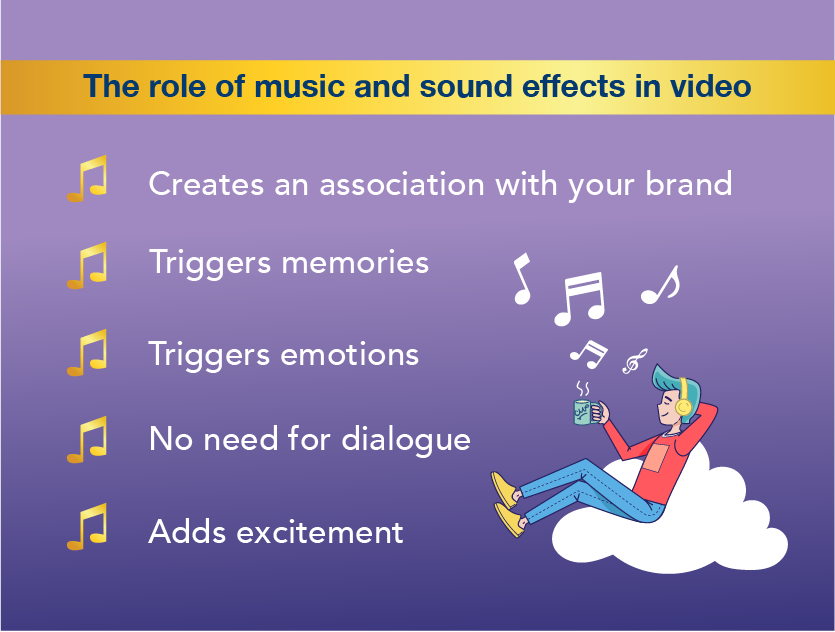

The role of music and sound effects in your video

Music sets the tone (pun intended) of your video and creates an immersive and memorable viewing experience for your audience.
Can you imagine watching Titanic without its iconic soundtrack playing in the background, pulling on your heartstrings? Probably not.
While Hollywood had its start in silent films (think Charlie Chaplin), the modern consumer would find it awkward and perhaps even uncomfortable to watch anything without music and sound effects.
Why they matter
In fact, ‘silent film’ is somewhat a misnomer. While the film reels themselves had no audio, public screenings of these silent films were often accompanied by live bands that would play music for the audience. If that doesn’t underscore the importance of sound, we don’t know what does.
Right from the start, music and sound were recognised as essential to the viewing experience, building the atmosphere and giving the audience vital emotional cues.
Its importance isn’t just limited to Hollywood blockbusters, but for any video — including your branding and marketing videos.
The role of music and sound effects

Creates an association with your brand
Music and sound effects can be one of the most identifiable ways brands leave a lasting impression in the minds of their audience, especially during a video.
Who can forget McDonald’s iconic jingle “I’m Lovin’ It”? We’re pretty sure you sang the tune in your head — almost everyone who owns a television has heard it at least once during their lifetime. And after so many years, it’s safe to say that one-liner is inextricably tied to the fast-food chain’s identity.
As a form of audio branding that can be used in TV and radio commercials, jingles help keep your brand top of mind for your audience, truly exemplifying the role that music and sound effects play in videos.
No matter the kind of video you’re making, be it an explainer or a documentary, using music will definitely help you build recognition value over time, especially if you use the same tunes consistently across your marketing assets.
Triggers memories
There is scientific proof that music can trigger powerful memories in the listener. In fact, hearing a song from the past can “trigger the sights, sounds, and feelings of a specific event associated with it”.
So what happens if you put in a song from the past into your brand video? If it’s a song that’s popular with your audience demographic, chances are you’ll help to establish positive connotations to your product or brand.
Watching your video (and listening to their favourite song playing in the background) will definitely help your brand stick out in the minds of your audience by helping them relate to your brand on a personal level.
Think about how this 2004 Chrysler commercial used Celine Dion’s appropriately-titled song “I Drove All Night” in their product showcase video to appeal to their mature audience demographics.
Using songs from these superstars will undoubtedly help viewers or fans to recall their memories and respective journeys with the artists themselves.
Triggers emotions
Music sets the tone of the video by triggering emotions, so you must first decide what message you want to convey to the audience when choosing it.
Is it happiness, sadness, or fear? Depending on the music you choose, you can change the tone of the video entirely. Look at this reimagined horror trailer for Willy Wonka and the Chocolate Factory, a children’s movie. Apart from smart editing of the clips, pay attention to how the choice of music creates a chilling effect.
And if you’re unconvinced about the role music and sounds play in creating emotions, just take a look at how different the majestic opening scene of the Lion King movie would be if its theme song ‘The Circle of Life’ was replaced with different tunes.
The Titanic soundtrack, for example, has orchestral strings that culminated in “My Heart Will Go On,” sung by Celine Dion as the credits rolled. All the music and sounds trigger viewers’ emotional response as they witness the main characters’ love journey; even men cried after watching the movie.
No dialogue required
You can tell stories just by having music playing in the background. It’s just as effective, if not better, in some instances.
While regular horror films tend to use dramatic noises for jump scares, box office hit A Quiet Place deviates from the usual formula. With minimal dialogue, it’s the clever but subtle sound engineering that helps tell the story of a family who is trying to survive in a world with blind but noise-sensitive monsters.
Although it’s true that it’s the quiet that creates a story filled with almost unbearable tension, it’s not a silent film per se. Rather, it’s the selective use of sounds and noises that keeps audiences on the edge of their seat. Every little creak and every hushed breath amplifies the sense of suspense and urgency in a cinematic world where sound means certain death.
Adds excitement
With the right kind of sound effects, you can turn regular videos into something that’s much more exciting. Sometimes, that sleek new convertible you see on TV isn’t actually as fast (or as cool) as it seems — it’s all done through the magic of sound editing and mixing.
Even if you’re working with stock footage, your final video doesn’t have to be boring. You just need to find the right kind of music to pace the story. Remember to match the audio with the movements on the screen, like what we’ve done for Wolters Kluwer.
Choosing the Right Music
Now that you know the benefits of having music in your video, here are three tips that you should consider in choosing one:
Determine the video’s mood
With the hectic production schedules, sound design might sometimes take a backseat to other more urgent tasks like storyboarding and scripting, only to be given full attention in the post-production process.
But as we’ve demonstrated, music can drastically affect your messaging, especially if it’s not appropriate or relevant to your content. It’s therefore important to align with your team on what type of mood you want to set in the video or scene right from the start, during the storyboarding and scripting process. Is it supposed to be funny, dramatic, or mysterious?
Know your target audience
Ask yourself this question, “Who’s going to watch my video?” Answering this question will help you cater to your audience when choosing music.
For instance, if you’re catering to teenagers, you may consider popular Top 40 songs, whereas if you’re selling children’s toys, you may choose playful or lively songs and nursery rhymes.
Have a budget and respect ownership
Heard the perfect song for your video on the radio or the Internet? You’re not allowed to download it off the internet directly — it’s illegal. That’s why you ought to set aside your marketing budget to purchase a license fee for a song. By doing so, you’ll be free from possible legal troubles down the road. Alternatively, you can also download royalty-free music on the Internet.
Videos without music are like fish and chips without its condiments. It enhances the viewing experience while also getting your message across more effectively. Incorporating music into your video is no longer optional but a must in today’s fast-paced marketing environment.
Have difficulties in opting for the proper music for your video? Contact our digital content director Erik at [email protected] today!
Read more from Click2View:
- How do you ace the Instagram Stories game?
- Explore the allure of animated content.
- Here are some AI content tools to try.
Sign up to our newsletter for a weekly update on the latest content marketing news. Don’t forget to subscribe to our YouTube channel too!
Click2View is Southeast Asia’s premiere full-service independent B2B content marketing agency servicing clients like Microsoft, Google, Visa, Prudential, and the Lee Kuan Yew School of Public Policy.








